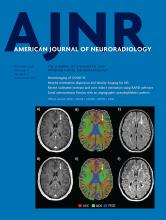Article Figures & Data
Tables
Variables Patients (n = 57) Sex (No.) (%) Male 29 (50.9%) Female 28 (49.1%) Age (mean) (range) (yr) 38.05 ± 18.1 (9–78) Previous rupture (No.) (%) 38 (66.6%) bAVM location (No.) (%) Cortical (lobar or cerebellum) 41 (72%) Deep (brain stem, thalamus, or basal ganglia) 16 (28.0%) Nidus diameter (original size) (mean) (cm) 2.91 ± 1.26 Nidus diameter before treatment by TVE (mean) (cm) 2.44 ± 0.99 Dilated vein (No.) (%) Evaluator 1 24 (42.1%) Evaluator 2 28 (49.1%) Evaluator 3 36 (63.1%) Pattern of venous drainage (No.) (%) Superficial 25 (43.9%) Deep 28 (49.1%) Superficial and deep 4 (7.0%) Venous collector (No.) (%) 1 37 (64.9%) 2 18 (31.6%) 3 2 (3.5%) Spetzler–Martin grade I 5 (8.8%) II 18 (31.6%) III 23 (40.4%) IV 10 (17.5%) V 1 (1.7%) Patient mRS before Treatment mRS before Discharge 6-Month Follow-Up mRS 1 0 0 0 2 0 1 NA 3 0 0 0 4 1 4 3 5 0 3 2 6 1 2 1 7 0 4 4 8 0 2 1 Note:— NA indicates not available.
- Table 3:
Univariate analysis showing the association between findings on HC and the clinical-anatomic-demographic variables of patients treated by TVE
Variable Were There HC? No (n = 49) Yes (n = 8) P Spetzler-Martin grading system 1.0a I, II, and III 39 (68.5%) 7 IV and V 10 (17.5%) 1 Previous rupture 1.0a No 16 3 Yes 33 5 Sex .70a Female 25 3 Male 24 5 Mean age on admission (SD) (yr) 37.1 (18.6) 46.8 (13.6) .16b No. of venous collectors (mean) (SD) 1.2 (0.45) 2.0 (0.75) .003c Presence of dilated draining vein (No.) (%) .06a Evaluator 1 = 24/57 18 (31.5%) 6 (10.5%) Presence of dilated draining vein (No.) (%) .14a Evaluator 2 = 28/57 22 (38.5%) 6 (10.5%) Presence of dilated draining vein (No.) (%) .69a Evaluator 3 = 36/57 30 (52.6%) 6 (10.5%) Pattern of venous drainage .48a Superficial 21 4 Deep 25 3 Superficial and deep 3 1 Nidus diameter before any intervention .01b (mean) (SD) (cm) 2.74 (1.19) 3.88 (1.40) Nidus diameter before TVE (mean) (SD) (cm) 2.28 (0.92) 3.37 (1.00) .003b Nidus diameter before TVE (2 groups) .03a 0–3 cm 38 3 >3 cm 11 5 AVM location .09a Cortical (lobar or cerebellum) 33 8 Deep (brain stem, thalamus, or basal ganglia) 16 0 - Table 4:
Univariate analysis showing the association between hemorrhagic complications and the technical variables of patients treated by TVE
Variable Were There Hemorrhagic Complications? No (n = 49) Yes (n = 8) P Arterial balloon .39a Yes 11 3 No 38 5 No. of embolization sessions,(mean) (SD) 1.8 (1.2) 1.8 (0.99) .50b Coiled vein 1.0a Yes 15 2 No 34 6 Total occlusion (angiographic cure) 1.0a Yes 44 8 No 5 0 ↵a Fisher exact test.
b Mann–Whitney test.












